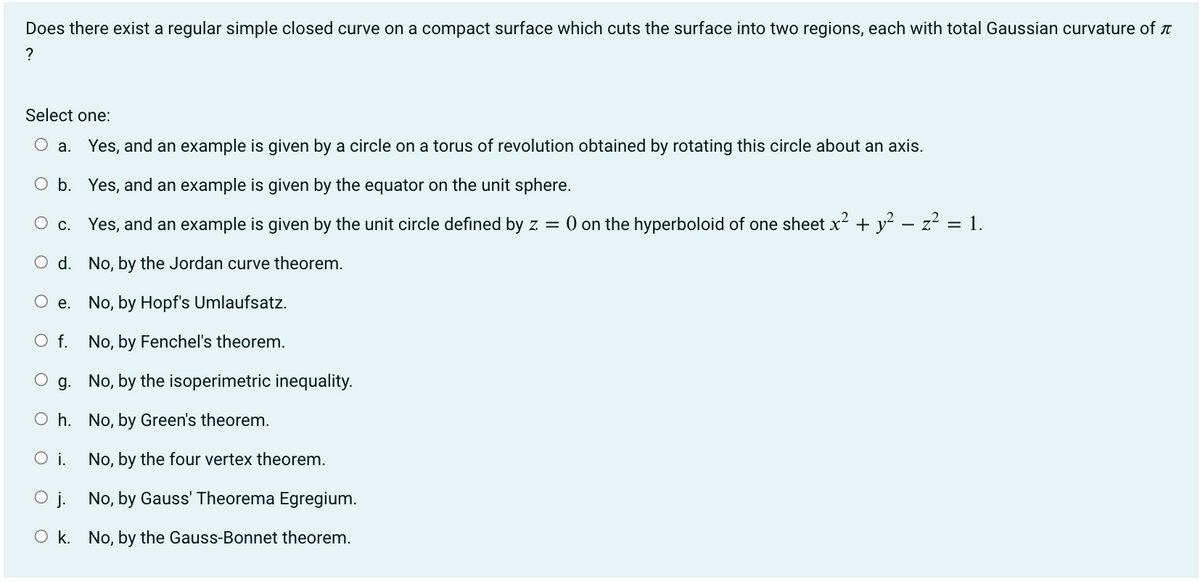Does there exist a regular simple closed curve on a compact surface which cuts the surface into two regions, each with total Gaussian curvature of ? Select one: O a. Yes, and an example is given by a circle on a torus of revolution obtained by rotating this circle about an axis. b. Yes, and an example is given by the equator on the unit sphere. О с. Yes, and an example is given by the unit circle defined by z = 0 on the hyperboloid of one sheet x² + y² = z² = 1. No, by the Jordan curve theorem. No, by Hopf's Umlaufsatz. O f. No, by Fenchel's theorem. Og. No, by the isoperimetric inequality. Oh. No, by Green's theorem. O i. d. O e. No, by the four vertex theorem. Oj. No, by Gauss' Theorema Egregium. Ok. No, by the Gauss-Bonnet theorem.
Does there exist a regular simple closed curve on a compact surface which cuts the surface into two regions, each with total Gaussian curvature of ? Select one: O a. Yes, and an example is given by a circle on a torus of revolution obtained by rotating this circle about an axis. b. Yes, and an example is given by the equator on the unit sphere. О с. Yes, and an example is given by the unit circle defined by z = 0 on the hyperboloid of one sheet x² + y² = z² = 1. No, by the Jordan curve theorem. No, by Hopf's Umlaufsatz. O f. No, by Fenchel's theorem. Og. No, by the isoperimetric inequality. Oh. No, by Green's theorem. O i. d. O e. No, by the four vertex theorem. Oj. No, by Gauss' Theorema Egregium. Ok. No, by the Gauss-Bonnet theorem.
Elementary Geometry For College Students, 7e
7th Edition
ISBN:9781337614085
Author:Alexander, Daniel C.; Koeberlein, Geralyn M.
Publisher:Alexander, Daniel C.; Koeberlein, Geralyn M.
Chapter9: Surfaces And Solids
Section9.4: Polyhedrons And Spheres
Problem 48E: Sketch the solid that results when the given circle of radius length 1 unit is revolved about the...
Related questions
Question
100%
Need help with this question. Please explain each step and neatly type up. Thank you :)

Transcribed Image Text:Does there exist a regular simple closed curve on a compact surface which cuts the surface into two regions, each with total Gaussian curvature of
?
Select one:
O a. Yes, and an example is given by a circle on a torus of revolution obtained by rotating this circle about an axis.
O b.
Yes, and an example is given by the equator on the unit sphere.
c.
Yes, and an example is given by the unit circle defined by z = 0 on the hyperboloid of one sheet x² + y² − z² = 1.
O d.
No, by the Jordan curve theorem.
No, by Hopf's Umlaufsatz.
No, by Fenchel's theorem.
No, by the isoperimetric inequality.
No, by Green's theorem.
No, by the four vertex theorem.
Oj.
No, by Gauss' Theorema Egregium.
Ok. No, by the Gauss-Bonnet theorem.
e.
O f.
g.
Oh.
O i.
Expert Solution
This question has been solved!
Explore an expertly crafted, step-by-step solution for a thorough understanding of key concepts.
Step by step
Solved in 3 steps with 2 images

Recommended textbooks for you

Elementary Geometry For College Students, 7e
Geometry
ISBN:
9781337614085
Author:
Alexander, Daniel C.; Koeberlein, Geralyn M.
Publisher:
Cengage,

Elementary Geometry For College Students, 7e
Geometry
ISBN:
9781337614085
Author:
Alexander, Daniel C.; Koeberlein, Geralyn M.
Publisher:
Cengage,